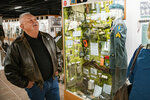
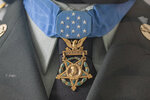
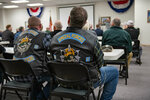
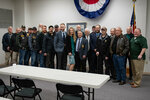
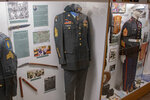
Fifty-four years to the day after a brutal battle unfolded in the Kon Tum province in Vietnam and nearly took the life of U.S. Army Green Beret Franklin Douglas Miller, his children, friends and other veterans gathered at the Veterans Memorial Museum on Friday, Jan. 5.
They were there for a ceremony unveiling a new display featuring the Medal of Honor that Miller was awarded after the battle.
While a staff sergeant at the time, Miller would go on to retire from the Army as a command sergeant major.
Among those in attendance Friday were 20 other Special Forces veterans, including retired Master Sergeant and Medal of Honor recipient Earl Plumlee, of Graham, along with several previous commanders of the 1st Special Forces Group from Joint Base Lewis-McChord.
Miller’s daughter, Danielle Keller, of Portland, has held onto her father’s Medal of Honor since his death in 2000, and had been considering the possibility of loaning the medal out to a museum to display. After considering other museums, Keller chose the Veterans Memorial Museum in Chehalis.
“They just instilled a lot of confidence that they would properly honor and take care of the medal,” Keller said.
The medal will be on display at the museum for the next two years, with a possibility for Keller to renew the contract. Keller may also temporarily take the medal from the museum for special ceremonies.
Fellow Green Beret and close friend of Miller, Skip Ettinger, who deployed with him in Vietnam, spoke at the ceremony Friday and shared how he trained Miller to use nunchucks.
“As soon as I got to Kon Tum, Frank had heard that I was a karate expert from Okinawa,” Ettinger said. “He was impressed and in awe with the nunchucks, so he and I would work out in the back of the compound and I would kind of teach him the more finer points of the nunchucks.”
If he ran out of ammunition during a battle, Miller wanted another deadly weapon he could still use in hand-to-hand combat, Ettinger said.
One of Miller’s teammates wanted to learn how to use the nunchucks as well, and asked to use the set Miller was training with.
“It didn’t work out so good. Ubi knocked himself out,” Ettinger said.
He told the audience he had donated the nunchucks he trained Miller with in Vietnam to be displayed alongside Miller’s Medal of Honor in the museum. In 2019, Ettinger was inducted into the USA Martial Arts Hall of Fame.
As for Miller’s display, his uniform stands next to Ettinger’s nunchucks with all of his medals and awards, including the Medal of Honor.
“It was definitely very striking,” said Keller. “... Placing (the medal) on there and seeing it, it was just a deep feeling of respect and gratitude and thankfulness.”
That respect is for what her father went through some 54 years ago, when he was on patrol as part of the 5th Special Forces Group leading a joint American-Vietnamese long-range reconnaissance patrol deep behind enemy lines.
Miller had noticed his patrol was suddenly very close to a large Vietcong unit and, while tactically evading the enemy force, one of Miller’s men tripped an explosive booby trap, injuring four other men in the unit.
An account of the battle, told by former Green Beret Keith McKim, was played at the ceremony on Friday.
Miller quickly administered first aid and moved his unit into a defensible position, as he knew the explosion alerted nearby Vietcong fighters.
Once his unit was secure in a defensible position, Miller went out alone to face a large enemy force — what he estimated to be around 100 fighters — approaching his unit’s position. Though his unit had managed to flee, they left a bloody trail that led the enemy right to them.
Miller single-handedly repulsed two initial enemy attacks before rejoining his unit and calling for a helicopter extraction for his men. However, the only suitable extraction point was a bomb crater some 150 meters from his unit’s position.
Miller scouted a route to the crater and led his men through the jungle to it, but as the helicopter hovered over the crater waiting to extract them, the Vietcong launched another attack against Miller’s unit and fired at the helicopter, forcing it to flee.
The enemy’s attack continued, leaving Miller heavily wounded. He was shot in the chest and stuffed a piece of his poncho-liner in the wound to stop the bleeding and keep fighting.
Despite the Vietcong’s persistence and his injuries, Miller continued to repel enemy advances until friendly forces reached their position and provided assistance.
And even then, Miller refused to leave until all of his men were on helicopters. Less than half the men in his patrol survived.
“Miller’s gallantry, intrepidity in action, and selfless devotion to the welfare of his comrades are in keeping with the highest traditions of the military service and reflect great credit on him, his unit, and the U.S. Army,” reads Miller’s Medal of Honor citation.
Miller died on June 30, 2000, in Florida. Following Miller’s death, on April 4, 2001, former President George W. Bush awarded the Presidential Unit Citation to the Studies and Observations Group Military Assistance Command in Vietnam Miller was attached to.
“The Studies and Observations Group is cited for extraordinary heroism, great combat achievement and unwavering fidelity while executing unheralded top secret missions deep behind enemy lines across Southeast Asia,” the Presidential Unit Citation read.
Those looking to learn more about Miller can read his book, “Reflections of a Warrior: Six Years as a Green Beret in Vietnam,” available from Amazon and other online retailers.
To see Miller’s Medal of Honor, visit the Veterans Memorial Museum at 100 SW Veterans Way in Chehalis.